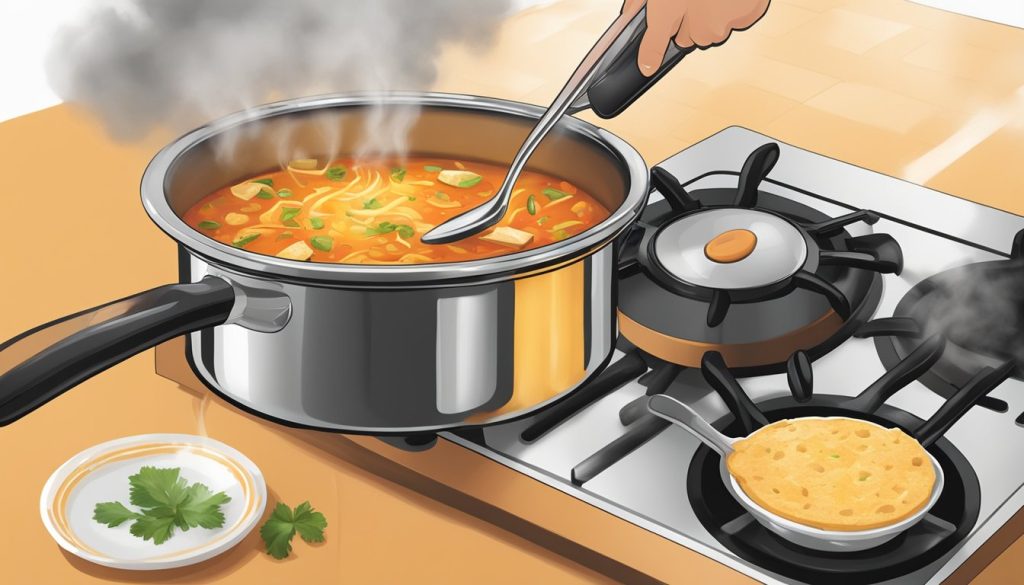Reheating tortilla soup can be a delicate process, as you want to maintain the flavors and textures that make this dish so beloved. The best way to reheat tortilla soup is on the stovetop over medium heat, stirring occasionally to ensure even warming without breaking down the ingredients. This method allows for gentle reheating that preserves the integrity of tender chicken pieces, beans, and other chunky components.
For those short on time, the microwave offers a quick alternative. Cover the bowl with a microwave-safe lid or plastic wrap to prevent splattering, and heat in short intervals, stirring between each. This approach works well for single servings and helps retain the soup’s moisture and flavor.
Proper reheating is crucial for enjoying leftover tortilla soup, whether it’s a homemade batch or takeout from popular spots like Jason’s Deli or Montana’s BBQ. By following these methods, you can savor your tortilla soup as if it were freshly made, making it an excellent option for meal prep or when you have extra servings to enjoy later.
Understanding Tortilla Soup

Tortilla soup is a flavorful Mexican dish that combines savory broth with a variety of textures and ingredients. Its robust taste and comforting qualities make it a popular choice for many.
Key Ingredients
Chicken broth forms the base of tortilla soup, providing a rich and savory foundation. Tender chunks of chicken add protein and substance. Corn and black beans contribute texture and nutritional value.
Chili powder gives the soup its characteristic warmth and depth of flavor. Many recipes include diced tomatoes, onions, and garlic for added complexity.
Tortilla strips are a crucial element, lending a satisfying crunch and thickening the broth slightly as they soften. Fresh toppings like avocado, cilantro, and lime juice often garnish the soup, enhancing its taste and appearance.
Soup Variations
While chicken is the most common protein in tortilla soup, vegetarian versions may use additional beans or vegetables instead. Some recipes incorporate seafood like shrimp for a coastal twist.
The level of spiciness can vary greatly between recipes. Some use jalapeños or chipotle peppers for extra heat, while others keep it mild. Regional variations may include different types of chilies or additional spices like cumin or oregano.
Tortilla soup can be served thick or thin. Thicker versions often blend some of the ingredients to create a heartier texture. Garnishes play a significant role in customizing the soup, with options like sour cream, cheese, or diced onions allowing diners to tailor it to their preferences.
Optimal Storage Tips

Proper storage of tortilla soup ensures food safety and preserves flavor. Following these guidelines will help maintain quality whether refrigerating or freezing your soup.
Short-Term Fridge Storage
Store tortilla soup in airtight containers in the refrigerator at temperatures below 40°F (4°C). This prevents bacterial growth and maintains freshness. Consume refrigerated soup within 3-4 days for best quality.
Cool soup quickly before refrigerating to minimize time in the temperature danger zone. Divide large batches into smaller portions to speed cooling. Use shallow containers to allow heat to dissipate faster.
Label containers with the date to track freshness. Keep soup away from raw meats to prevent cross-contamination. Reheat thoroughly to 165°F (74°C) before serving.
Long-Term Freezer Storage
Freeze tortilla soup for longer storage, up to 4-6 months. Use freezer-safe containers or heavy-duty freezer bags, leaving space for expansion. Remove excess air to prevent freezer burn.
Cool soup completely before freezing. Freeze in portion sizes for easy thawing and reheating. Label containers with the date and contents.
Store at 0°F (-18°C) or below for best quality. Thaw frozen soup in the refrigerator overnight before reheating. Add fresh toppings after reheating to maintain texture.
Reheating Techniques Overview

Tortilla soup can be reheated using several effective methods. Each technique offers distinct advantages for preserving flavor and texture.
Stovetop Method
The stovetop method provides precise control over temperature and allows for easy stirring. Pour the soup into a saucepan and heat over medium-low flame. Stir occasionally to distribute heat evenly and prevent sticking.
Add a small amount of broth or water if the soup appears too thick. Heat until the soup reaches a gentle simmer, typically 5-7 minutes. Avoid rapid boiling, as this can overcook ingredients and alter textures.
For best results, cover the pan between stirs to retain moisture and heat. This method works well for larger portions and helps maintain the soup’s original consistency.
Microwave Method
Microwaving offers quick and convenient reheating for single servings. Transfer soup to a microwave-safe bowl, leaving room for expansion. Cover loosely with a microwave-safe lid or plastic wrap to prevent splatters.
Heat on medium power for 1-2 minutes. Stir and check temperature. Continue heating in 30-second intervals, stirring between each, until desired temperature is reached.
Be cautious of hot spots. Let the soup stand for a minute after heating to allow temperature to equalize. This method is ideal for small portions but may not heat as evenly as stovetop reheating.
Oven Method
Oven reheating works well for large batches and helps maintain consistent temperature. Preheat oven to 350°F (175°C). Transfer soup to an oven-safe dish and cover with foil.
Heat for 20-30 minutes, stirring halfway through. Check temperature and consistency, adding liquid if needed. This method takes longer but produces even heating and helps preserve flavors.
For crispy tortilla strips, remove foil during the last 5 minutes of heating. The oven method is great for entertaining, as it keeps soup warm for extended periods.
Step-by-Step Reheating Instructions
Reheating tortilla soup properly ensures the best flavor and texture. The method you choose depends on time constraints and available equipment.
Reheating on the Stovetop
Pour the tortilla soup into a saucepan. Heat over medium-low, stirring occasionally. This method works well for both fresh and frozen soup.
For frozen soup, break it into chunks before heating. Add a splash of broth or water if needed. Heat until the soup reaches 165°F (74°C), typically 5-7 minutes for refrigerated soup or 10-12 minutes for frozen.
Stir gently to distribute heat evenly. This preserves the soup’s texture and prevents burning. Once hot, ladle into bowls and serve immediately.
Reheating in the Microwave
Transfer soup to a microwave-safe container. Cover with a microwave-safe lid or plastic wrap, leaving a small vent.
Microwave on medium power for 2-3 minutes. Stir and check temperature. Continue heating in 30-second intervals until it reaches 165°F (74°C).
For frozen soup, use the defrost setting first. Then heat on medium power, stirring every minute. This process may take 5-7 minutes total.
Let the soup stand for 1 minute before serving. Stir well to distribute heat evenly.
Reheating in the Oven
Preheat the oven to 350°F (175°C). Transfer soup to an oven-safe dish. Cover tightly with foil to prevent moisture loss.
Place the dish in the oven. Heat for 20-25 minutes for refrigerated soup, or 30-35 minutes for frozen. Stir halfway through for even heating.
Check the temperature with a food thermometer. The soup should reach 165°F (74°C) throughout. If needed, return to the oven for additional 5-minute intervals.
Once hot, carefully remove from the oven. Stir gently and serve in bowls while still steaming.
Enhancing Post-Reheat Flavor

Reheating tortilla soup provides an opportunity to elevate its taste profile. Adding fresh elements and adjusting seasonings can transform leftover soup into a delicious meal.
Fresh Toppings Addition
Incorporating fresh toppings enhances the texture and flavor of reheated tortilla soup. Chopped cilantro adds a bright, herbaceous note that complements the soup’s rich base. A squeeze of lime juice introduces a zesty tang, balancing the savory elements.
Diced avocado provides a creamy contrast to the soup’s broth. Shredded cheese, such as cheddar or Monterey Jack, melts slightly when added to hot soup, creating a delightful richness.
For added crunch, consider topping with crisp tortilla strips or crushed tortilla chips. Fresh jalapeño slices can introduce a spicy kick for those who enjoy heat.
Adjusting Seasonings After Reheat
Reheating can sometimes mute flavors, making it necessary to adjust seasonings. A pinch of salt can revive the soup’s overall taste. For depth, a dash of cumin or chili powder works well.
If the soup lacks acidity, a splash of lime juice or vinegar brightens the flavors. To increase heat, add a few drops of hot sauce or a sprinkle of cayenne pepper.
Fresh herbs like oregano or thyme can introduce new flavor dimensions. For a smoky note, consider adding a small amount of chipotle powder.
Taste the soup after each addition to ensure balanced flavors. Remember, it’s easier to add more seasoning than to correct over-seasoning.
Food Safety Considerations

Proper food safety practices are crucial when reheating chicken tortilla soup. Always ensure the soup reaches an internal temperature of 165°F (74°C) to kill any potential harmful bacteria.
Use a food thermometer to check the temperature at the center of the soup. Stir the soup occasionally during reheating to distribute heat evenly throughout.
Refrigerate leftover soup within 2 hours of cooking or serving. Store it in shallow, airtight containers to promote rapid cooling and prevent bacterial growth.
Consume refrigerated tortilla soup within 3-4 days for optimal safety and quality. If freezing, use within 2-3 months for best results.
When reheating frozen soup, thaw it in the refrigerator overnight before reheating. Avoid leaving soup at room temperature for extended periods.
Discard any soup left out at room temperature for more than 2 hours, or 1 hour if the ambient temperature is above 90°F (32°C).
If the soup develops an off odor, appearance, or texture, it’s best to err on the side of caution and discard it.
Conclusion

Reheating tortilla soup properly preserves its flavors and textures. The stovetop method offers precise control, allowing gentle reheating while stirring occasionally.
Microwaving provides a quick option, though care must be taken to avoid overheating. Use short intervals and stir between each to ensure even warming.
The oven method works well for larger portions. Cover the soup to retain moisture and heat at a moderate temperature.
Regardless of method, avoid boiling to prevent ingredient breakdown. Reheat only until steaming hot.
Serve immediately after reheating for the best taste and texture. Garnish with fresh toppings like tortilla strips, avocado, or cilantro to enhance the soup’s flavors and presentation.
With these techniques, leftover tortilla soup can be just as delicious as when freshly made.
